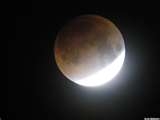BY BECCY TANNER-The Wichita Eagle
The moon appears totally covered by shadow as the earth passes between the moon and the sun, during the lunar eclipse in this Jan. 9, 2001 file photo taken in Kiel, Germany. On Tuesday Dec. 21, 2010 the first day of northern winter, the full Moon passes almost dead-center through Earth’s shadow. The eclipse begins at 1:33 am EST. At that time, Earth’s shadow will appear as a dark-red bite at the edge of the lunar disk. It takes about an hour for the “bite” to expand and swallow the entire Moon. Totality commences at 2:41 am EST and lasts for 72 minutes. According to NASA the last total lunar eclipse that happened on the winter solstice was Dec. 21, 1638. The next one will Dec. 21, 2094. (AP Photo/Heribert Proepper, File)
The moon will put on a three-hour show early Tuesday, slowly disappearing, turning copper red, and reappearing.
The red part ?? a full eclipse, with the Earth’s companion orb covered by the Earth’s shadow ?? is expected to last from 1:41 to 2:53 a.m.
The shadow will start to creep across the moon at 12:32 a.m. and disappear at 4:01.
Some ancient civilizations believed a lunar eclipse meant a dragon was in the sky, eating the moon and flooding the sky with its blood, while other civilizations banged pots and pans until the moon simply reappeared.
“To me, it is a mathematical process,” said Robert Henry, assistant director of the Fairmount Center for Science and Mathematics Education at Wichita State University. “The moon has a tilt and the Earth has a tilt and we align twice a year.”
Or, if you wish, Henry said: “That will be bite, bite, bite, totality and then, bite, bite, bite” full moon again.
“It is red because the light from the sun is being refracted through the Earth’s atmosphere,” he said.
Lunar eclipses occur when Earth’s shadow crosses the moon. The outer shadow is called the penumbra, and the dark, inner shadow is called the umbra.
A partial eclipse occurs when only a portion of the moon enters the umbra. When the moon travels completely into the Earth’s umbra, that’s a total eclipse.
But this one is special: It falls on the winter solstice, or the morning of the longest night of the year. After Tuesday, the days will slowly begin to lengthen again.
According to the National Weather Service, a solstice total lunar eclipse is rare.
“The US Naval Observatory inspected a list of eclipses going back 2000 years,” the Weather Service said on its website. “Until this year, there was only one such occurrence, way back on December 21, 1638. The next such occurrence will be on December 21, 2094.”
Although the forecast for the Wichita area is for some clouds Monday night into Tuesday morning, the skies aren’t expected to be overcast.
The last total lunar eclipse Wichitans were able to watch was in 2007, Henry said.
Is this lunar eclipse enough to excite astronomers?
“Oh, heck yes,” Henry said. “It is something that doesn’t happen often. Unlike meteor showers, you don’t need to be somewhere where it is dark to see it properly. You can be in the middle of the city, anywhere, and poke your head outside and watch.”
And don’t forget to watch for the moon to turn red.
Read more: http://www.kansas.com/2010/12/20/1641057/lunar-eclipse-at-solstice-a-rare.html#ixzz18f90UVRA

